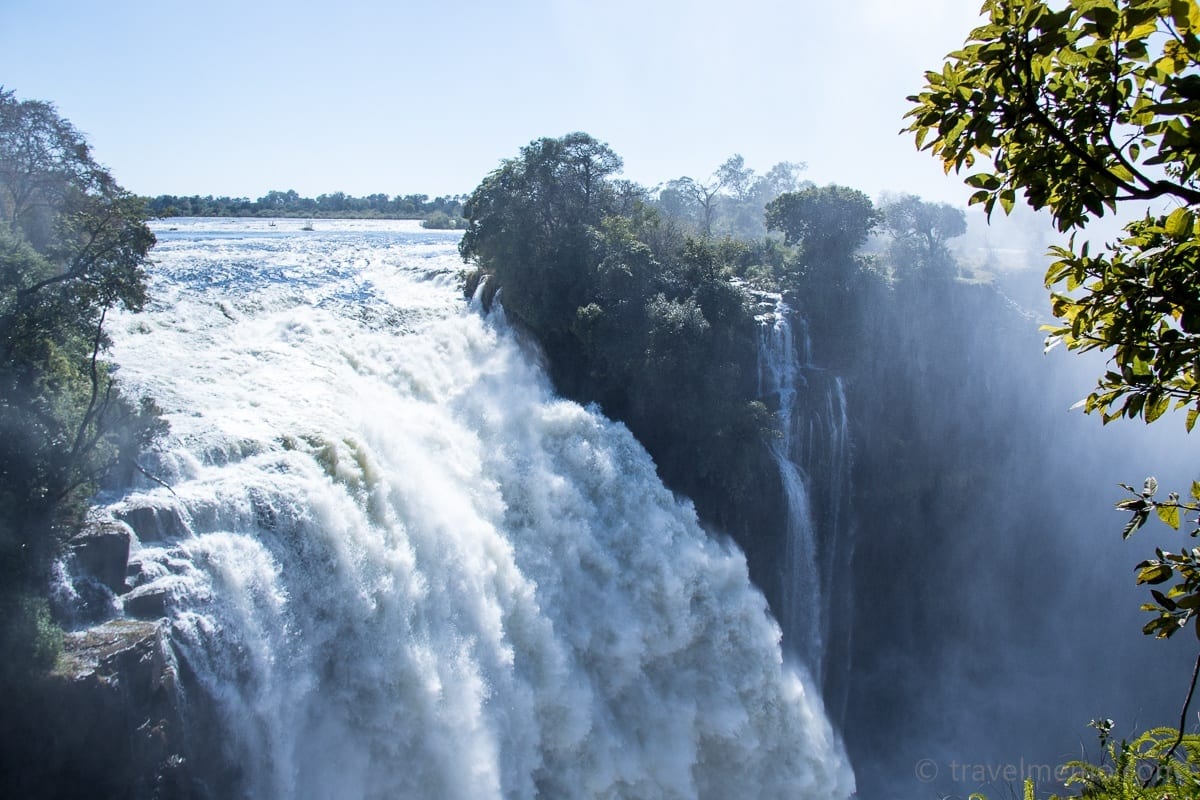It so happened that during our South America travels we had missed out on the Iguazu waterfalls in Argentina. There’s just no way you can be everywhere all the time. So, for our African safari in Botswana I insisted all the more on including Victoria Falls in the itinerary. Just so we could get sopping wet — in brilliant sunshine!
To be sure, yes, our Swiss Rhine Fall is absolutely spectacular — but even so, it “can’t hold water” to Victoria Falls. That’s because in Victoria Falls you see nature at play on such a gigantic scale that it could even be considered the largest waterfall in the world; it just depends on how you measure it. But more on this later…
Victoria Falls make an earthshaking noise and, under the right conditions toward the end of the rainy season, the mist billowing so high above the falls can still be seen from more than 30 kilometers away! Or from your plane on its approach…
We booked a guided tour to learn all we could about this thundering mass of water. We were guided to the falls by our expert “Clouds” (his real name!) of Africa Travel Vicfalls. The falls that have been roaring for millions of years offer a truly breathtaking spectacle from each of the 16 overlooks he took us to. At every stop and in between, Clouds filled us in on a multitude of factoids and historical dates about this wonder of the world.
It was the famous British Africa explorer David Livingstone who “discovered” Victoria Falls in 1855. When he first saw the mighty falls from the only accessible speck of land in the middle of the Zambezi River (called “Livingstone Island” today) he promptly named them after his then-reigning queen.
The indigenous people, it should be said, also call the spectacular show put on by nature “Mosi-oa-Tunya” (“the smoke that thunders”), which is a very apt description for this awesome ensemble of spray, mist, and the constant roar. Here is our attempt at capturing the grandeur:
Victoria Falls were created when tectonic shifts opened a cleft in the hard basaltic rock surface. Even today, the geological situation is far from fixed: the subsurface consists partly of sandstone, which causes the waterfalls to slowly shift north as they wear away the rock. Close measurement of this migration lets scientists predict from what vantage points visitors in coming decades will view Victoria Falls.
The only question is, what will happen to the border between Zimbabwe and Zambia? :-)
In 1989, UNESCO declared Victoria Falls a World Natural Heritage Site. Although the waterfall is neither the highest nor the widest in the world, it is nevertheless the biggest, because measuring 1,708 meters wide and 108 meters high does make it the world’s single largest stretch of falling water.
The Victoria Falls Bridge
The venerable rail, automobile, and bungee-jumping bridge was erected in 1905 by Sir Ralph Freeman, a steel connector between what today are the countries of Zambia and Zimbabwe. (To be sure, there was no bungee jumping at the time…)
It was Cecil John Rhodes who came up with the idea for a bridge over the waterfalls. His dream was to ride the train from Cairo to Capetown and feel the “spray from the waterfalls on the train cars” in between.
Not exactly a small vision, I have to admit… Unfortunately, he bridge had not been completed by the time he died, so that he missed his dreamed-of train ride the length of the continent.
The 198-meter long bridge spans the immense chasm at a height of 128 meters. The construction is also renowned in bungee jumping circles for a breathtaking 111 meter, 4-second bungee jump into the rainbow mist; the jump is known as the “Shearwater bungee.”
We left younger adrenaline junkies to take that plunge, determined as were to keep terra firmly under our own feet.
Pointers: The user fee for Victoria National Park currently amounts to USD 30 per person. And, do not forget your rain gear! All the sunshine in the world will not keep you from getting soaked by the spray. And not just soaked, but sopping, dripping wet: like it was raining buckets!
Walter at least laughed uproariously every time a bucket doused him and his floppy hat. That’s how “shocking” the whole experience was ;-)
Had we known what awaited us, the hiking boots would have stayed behind high and dry and been replaced by rubber sandals… but at least the camera proved to be spray proof. Lucked out there!
